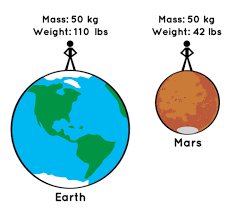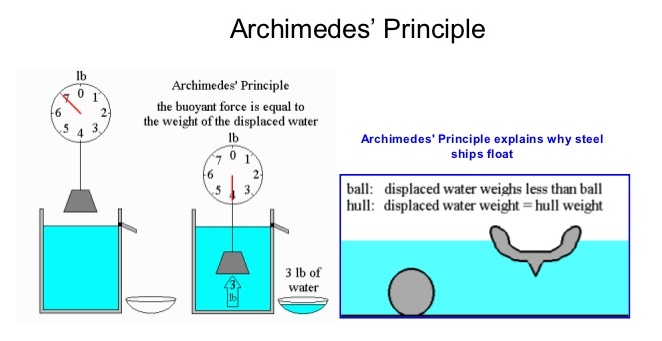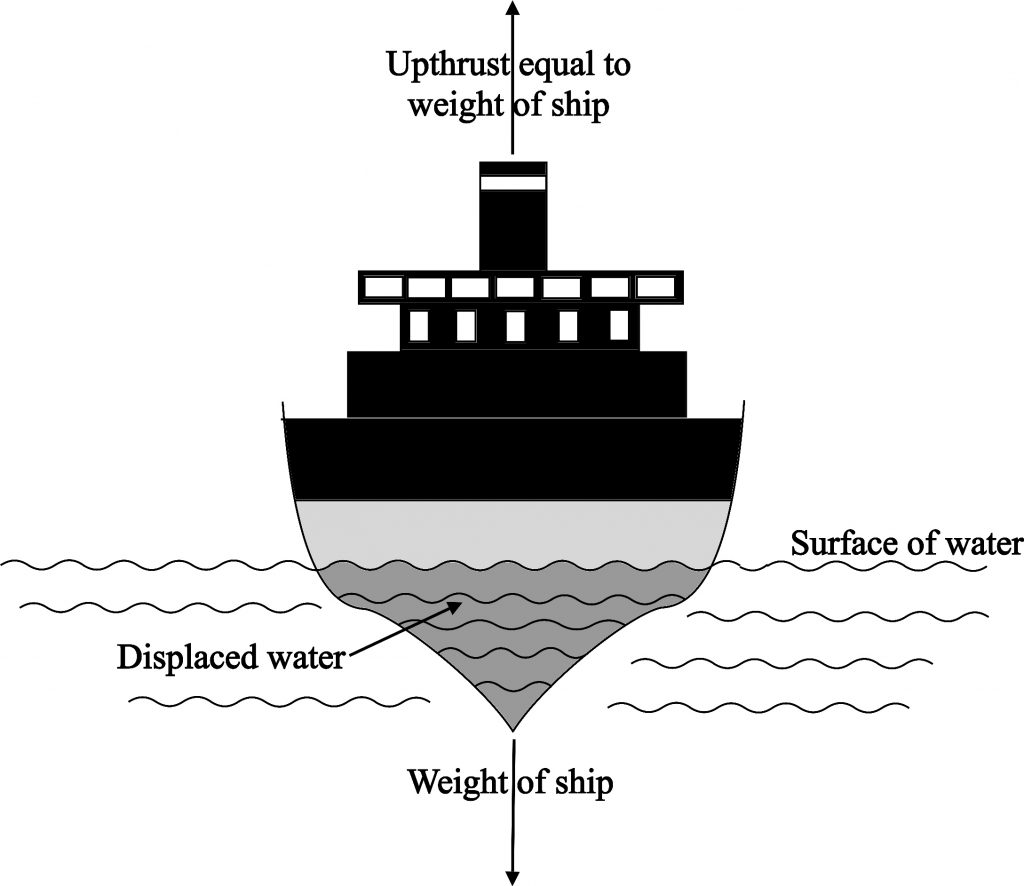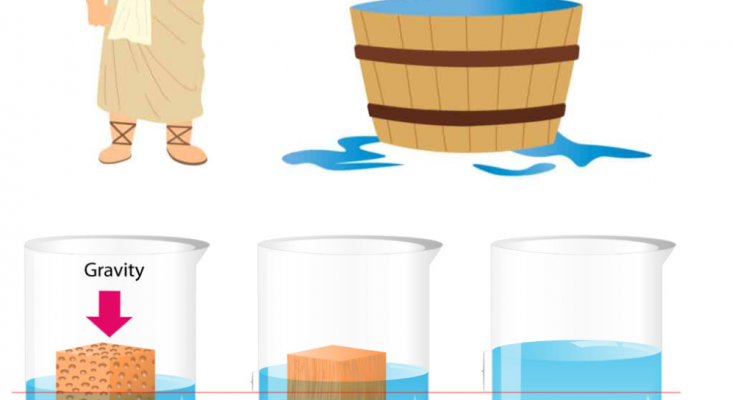What do you mean by mass?
- Mass is the measure of the amount of matter in a body.
- The SI unit of mass is Kilogram (kg).
- The mass of a body does not change at any time.
What do you mean by weight?
- It is the measure of the force of gravity acting on a body.
- The formula for weight is given by:
w = mg
where m is mass of the body and g is the pull of gravity
- The unit of weight is similar to that of force i.e. newton.
- Weight varies according to location.

What do you mean by volume?
Volume is defined as the three-dimensional space occupied by matter or enclosed by a surface. The SI unit of volume is the cubic meter .
Examples of volume are common in daily life:
- A student uses a graduated cylinder to measure the volume of a chemical solution in millilitres.
- You can purchase a quart, half-gallon, or gallon of milk.
What is the relationship between volume and weight?
When the volume of a substance increases, its weight also increases. More the weight of the substance, the greater will be its volume.We can say that the volume of the object is directly proportional to its mass. As the volume increases the mass of the object increases in direct proportion.
Density:
- A material’s density is defined as its mass per unit volume.
- Density is essentially a measurement of how tightly matter is packed together.It shows how much heavy an object is at constant volume.
- It is a unique physical property for a particular object.
- The principle of density was discovered by the Greek scientist Archimedes.
The symbol ρ represents density or it can also be represented by the letter d.Density can be explained as the relationship between the mass of the substance and the volume it takes up.
The formula for density is d = M/V, where d is density, M is mass, and V is volume.
Different substances have different density, which means for the same volume of different substances weigh differently.
Also Check – Force , work and Energy Class 5 – complete Notes
Floating and Sinking
- Whether something floats depends on the material it is made of or density of the material, not its weight.
- Objects float if they are less dense and sink if they are more denser in comparison to the medium on which the objects float.( most of the time the medium used is water)
Density of water=1 kg per litre This means 1 litre of water weighs 1 kg
Densities of wood, cotton wool and wax<1 kg per litre. So, these substances will float in water.
Densities of aluminium and iron are greater>1 kg per litre. So They will sink in water
- An object can be light for its size if it contains air, such as a hollow ball.
- Materials with a boat shape will float because they effectively contain air.
- Water pushes up on objects with an upthrust force.
- To float, the weight force on an object must be balanced by the upward push by the water on the object.
- So the rules for floating and sinking according to Archimedes’ principle are:
- If the weight of an object is more than the upthrust, the object sinks in water.
- If the upthrust is more than the weight of an object, the object floats in water.
Example: Drop a lump of clay in water. It will sink. Then mould the lump of clay into the shape of a boat, and it will float. Because of its shape, the boat displaces more water than the lump and experiences a greater buoyant force. The same is true of steel ships.
Also Check –Force work And Energy Question and answers
Archimedes Principle
Archimedes’ principle states that:
“The upward buoyant force that is exerted on a body immersed in a fluid, whether partially or fully submerged, is equal to the weight of the fluid that the body displaces and acts in the upward direction at the centre of mass of the displaced fluid”.
Upthrust Or Buoyant Force
The buoyant force is the upward force exerted on an object wholly or partly immersed in a fluid. This upward force is also called Upthrust. Due to the buoyant force, a body submerged partially or fully in a fluid appears to lose its weight, i.e. appears to be lighter.
Following factors affect buoyant force:
- the density of the fluid
- the volume of the fluid displaced
- the local acceleration due to gravity

Explanation of Archimedes Principle:
Archimedes’ principle deals with the forces applied to an object by fluids surrounding it. This applied force reduces the net weight of the object submerged in a fluid.
- If the weight of the water displaced is less than the weight of the object, the object will sink
- Otherwise the object will float, with the weight of the water displaced equal to the weight of the object.
- Density plays a crucial role in Archimedes’ principle.
- The average density of an object is what ultimately determines whether it floats.
- If its average density is less than that of the surrounding fluid, it will float. This is because the fluid, having a higher density, contains more mass and hence more weight in the same volume. The buoyant force, which equals the weight of the fluid displaced, is thus greater than the weight of the object.
- Likewise, an object denser than the fluid will sink. The extent to which a floating object is submerged depends on how the object’s density is related to that of the fluid.

A ship is made of iron, but it still floats in water. Why?

- This is because of its shape. A ship is hollow. The air that is inside a ship is much less dense than water. That’s what keeps it floating!
- When the ship is in water, the entire volume of the ship, including the hollow portion, displaces water to make space for itself.
- Thus, the volume of water displaced is much more than the volume of iron used in the ship.
- So, according to Archimedes’ principle, the upthrust is also very high—more than the weight of the ship. Therefore, the ship floats in water.
- Also, the average density of the total volume of the ship and everything inside of it (including the air) must be less than the same volume of water.
- If the average density of the ship is ever greater than the density of water, then the ship will sink beneath the surface of the water.

Weight of water
You have seen that when a brick is immersed in water, it appears to weigh less. You have also seen that if a brick of volume 1 litre and weight 2 kg is immersed in water, an upthrust equal to the weight of 1 kg acts on it upwards. So, the force
acting downwards when the brick is immersed in water is only 1 kg, compared to 2 kg when in air. So the brick weighs only 1 kg in water. So:
weight of an object in water = weight in air – upthrust
Or in other words:
weight of an object in water=weight in air – weight of water displaced
The weight of an object in water is called its apparent weight.
Apparent weight = weight in air – weight of water displaced
The loss of weight of an object when immersed in water is known as the apparent loss in weight.
apparent loss in weight = weight in air – apparent weight = weight of water displaced
Therefore, when an object is immersed in water, it loses weight equal to the weight of water displaced by it.
